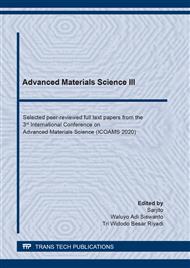[1]
He Li, Fei hua Liu, et.al, Synergetic enhancement of mechanical and electrical strength in epoxy/silica nanocomposites via chemically-bonded interface, J. Composites Science and Technology, (2018), Volume 167, Pages 539-546.
DOI: 10.1016/j.compscitech.2018.08.047
Google Scholar
[2]
Kępczak, W. Pawłowski, L. Kaczmare, Cast Iron And Mineral Cast Applied For Machine Tool Bed - Dynamic Behavior Analysis, archives of metallurgy and materials, (2015), Volume 60, issue 2.
DOI: 10.1515/amm-2015-0254
Google Scholar
[3]
Pawel Dunaj, Tomasz Okulik, Bartosz Powalka, Stefan Berczyński, Experimental Investigations of Steel Welded Machine Tool Bodies Filled with Composite Material, Energy Transfer and Dissipation in Plasma Turbulence, pp.61-69, (2019).
DOI: 10.1007/978-3-030-16943-5_6
Google Scholar
[4]
Sung-Kyum Cho, Hyun-Jun Kim, Seung-Hwan Chang, Chung-Ang, The Application of Polymer Composites to The Table Top Machine Tool Components For Higher Stiffness and Reduced Weight, j.Composite Structures, 2011, 93 (2):492-501.
DOI: 10.1016/j.compstruct.2010.08.030
Google Scholar
[5]
Dominik Hermansky, Jiri Marek, Steel Composite Material in CNC Machine Tool Structures, J.Acta Mechanica Slovaca ,Vol .20,(2): 56 - 60, (2016), ISSN 1335-393.
DOI: 10.21496/ams.2016.015
Google Scholar
[6]
Tsung-Chia Chen, Yong-Jun Chen, Ming-Hung Hung and Jui-Pin Hung, Design analysis of machine tool structure with artificial granite, material Adv.in Mechanical Engineering, (2016), Vol.8.1-4.
DOI: 10.1177/1687814016656533
Google Scholar
[7]
Suman Kumar Adhikary, Zymantas Rudzionis, R Rajapriya, The Effect of Carbon Nanotubes on the Flowability, Mechanical, Microstructural and DurabilityProperties of Cementitious Composite: An Overview, J. Sustainability, (2020),Vol.12, 8362, pp.1-25.
DOI: 10.3390/su12208362
Google Scholar
[8]
Douba, A, Emiro glu, M. Kandil, U.F. Taha, M.M.R, Very ductile polymer concrete using carbon nanotubes, J.Constr. Build. Mater., (2019), vol 196, p.468–477.
DOI: 10.1016/j.conbuildmat.2018.11.021
Google Scholar
[9]
Susilo Adi Widyanto, Achmad Widodo, Sri Nugroho, David Siahaan, The effect of geometric structure on stiffness and damping factor of wood applicable to machine tool structure, J. of Sci. and Eng., (2013), Vol. 4 (2), p: 57-60.
DOI: 10.12777/ijse.4.2.57-60
Google Scholar
[10]
Dong Qian, Gregory J Wagner, and Wing Kam Liu, Min-Feng Yu, Rodney S Ruoff, Mechanics of carbon nanotubes, 2002, Appl Mech Rev vol 55, no 6, November (2002).
Google Scholar
[11]
Rafique, I., Kausar, A., Anwar, Z., Muhammad, B., Exploration of epoxy resins, hardeningsystems, and epoxy/carbon nanotube composite designed for high performance materials: A review. J. Polym. Technol. Eng. (2015), Vol 55, 312–333.
DOI: 10.1080/03602559.2015.1070874
Google Scholar
[12]
Mendy Aisha Ramdhiani, Alwin Mugiyantoro, Sutarto, Analisa Unsur Utama dan Unsur Jejak Dalam Identifikasi Petrogenesis Pada Batuan Beku Gunung Galunggung, Jawa Barat, Proceeding, Seminar Nasional Kebumian Ke-11, Perspektif Ilmu Kebumian Dalam Kajian Bencana Geologi di Indonesia, 2018, p.707.
DOI: 10.5614/bull.geol.2018.2.2.5
Google Scholar
[13]
Junkai Wang, Xiangong Deng, et.al, Synthesis Of Carbon Nanotubes Via Fe-Catalyzed Pyrolysis Of Phenolic Resin, Physica E: Low-dimensional Systems and Nanostructures, (2017), Vol 86, p.24–35.
DOI: 10.1016/j.physe.2016.09.016
Google Scholar
[14]
Khanif Setiyawan, Bambang Sugiantoro, Utis Sutisna, Rusnaldy, Susilo Adi Widyanto, Analysis of Physical and Mechanical Properties of Multiwall Carbon Nano Tubes (MW-CNTs) Reinforced Mineral Composites as an Environmentally Friendly Machine Base Structure, J. Rekayasa Mesin, (2019), eISSN 2477-6041, article14th, pp.339-352.
DOI: 10.21776/ub.jrm.2019.010.03.14
Google Scholar
[15]
Mitja Linec, Branka Mušič, The Effects of Silica-Based Fillers on the Propertiesof Epoxy Molding Compounds, J. Materials.(2019),12, 1811, 1-11.
DOI: 10.3390/ma12111811
Google Scholar
[16]
Mohammad KazemHassanzadeh Aghdam, RezaAnsari, AbolfazlDarvizeh, Micromechanical analysis of carbon nanotube-coated fiber-reinforced hybrid composites, International Journal of Engineering Science, Volume 130, (2018), Pages 215-229.
DOI: 10.1016/j.ijengsci.2018.06.001
Google Scholar
[17]
Raman Bedi, Rakesh Chandra, SP Singh, Mechanical Properties Of Polymer Concrete, J. Composites, (2013) pp.1-12.
Google Scholar
[18]
A. Selvakumar, P.V. Mohanram, Evaluation of Effective Thermal Conductivity for Mineral Cast Structural Materials Using Steady-State and Transient Methods, Journal of Testing and Evaluation, (2013), Vol. 41, No. 4.
DOI: 10.1520/jte20120216
Google Scholar


